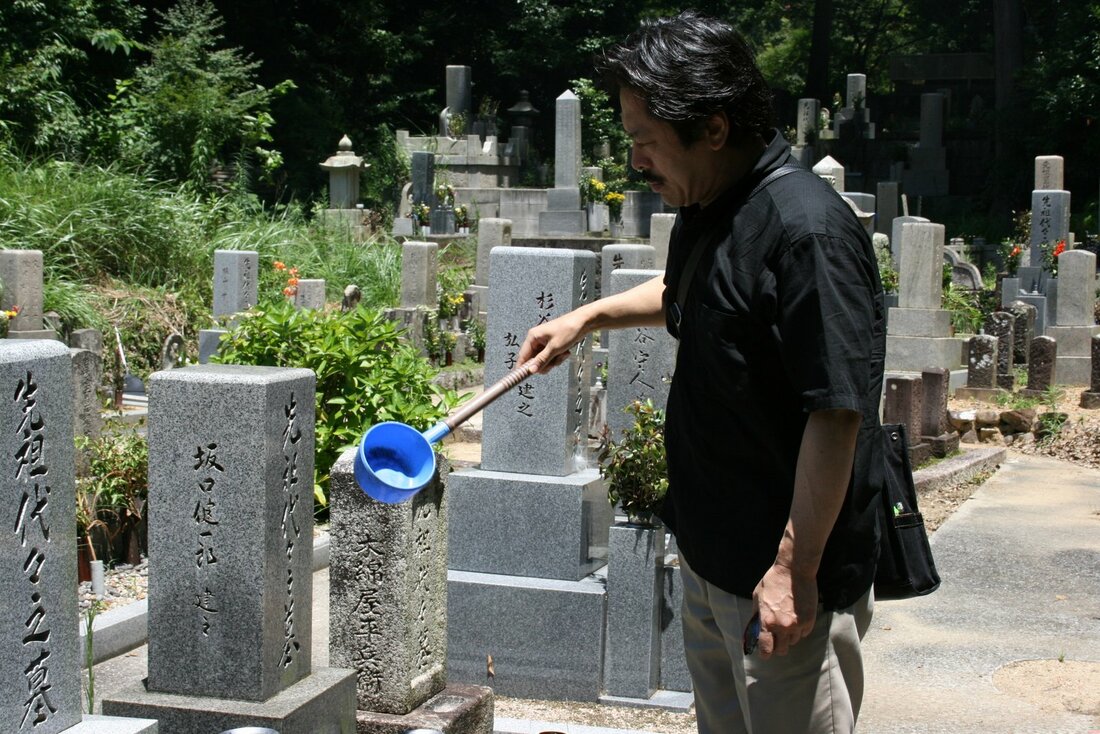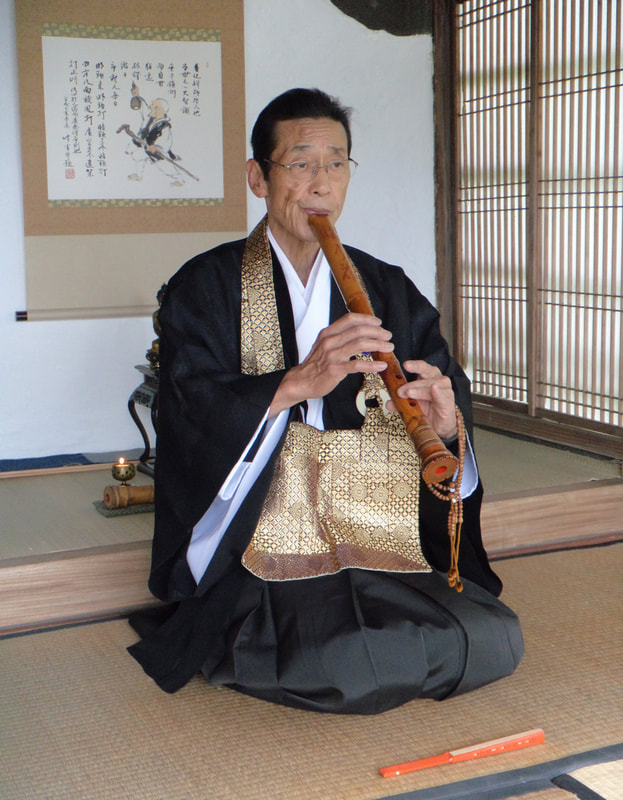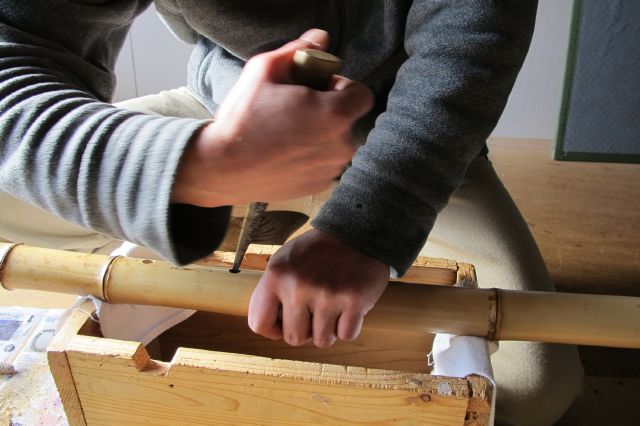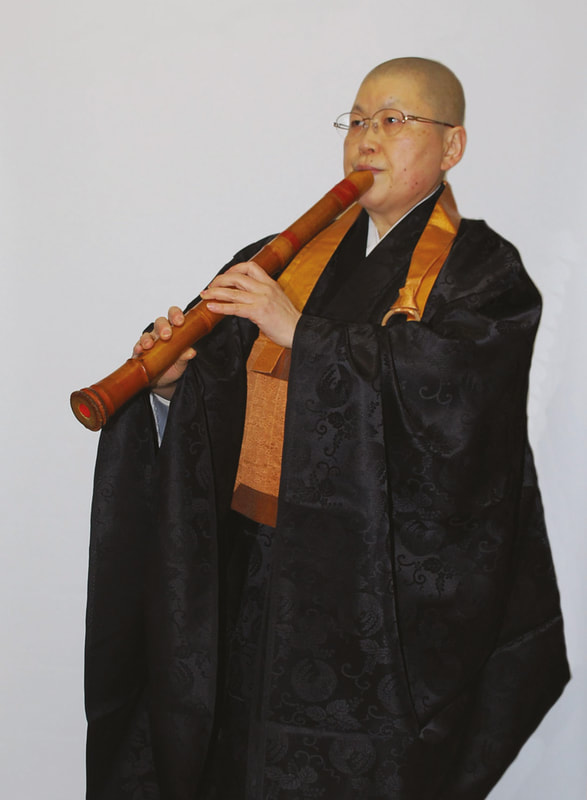FIRST EDITS:
SYNOPSIS
The shakuhachi (Japanese end-blown vertical bamboo flute) has become a popular world instrument. Together with the taiko drum, it is the Japanese instrument which has enjoyed most success abroad, and is employed today in jazz, pop, hollywood films, etc.
For many decades, however, the shakuhachi hid two major secrets:
While the modern instrument and some of the larger guilds that emerged in the late 19th and early 20th century became a mainstay of the professionalised Japanese traditional music world, a few players, seeking spiritual enlightenment, continued to play the older type of flute, using the traditional repertoire and playing styles/techniques. These players were marginalised and ignored as amateurs and religious eccentrics, while players educated at conservatories or in the large mainstream guilds became the representatives of shakuhachi. This film focuses on players of the old style flute and the rural temple repertoires, among the many ignored for decades.
For many decades, however, the shakuhachi hid two major secrets:
- Firstly the construction of the modern instrument had changed from that of the traditional instrument, something not apparent from the outside, but which played a great role for its sound.
- Secondly, the repertoire and playing styles changed after the abolition of the Fuke sect - a subsect of Rinzai Zen Buddhism - in 1871.
While the modern instrument and some of the larger guilds that emerged in the late 19th and early 20th century became a mainstay of the professionalised Japanese traditional music world, a few players, seeking spiritual enlightenment, continued to play the older type of flute, using the traditional repertoire and playing styles/techniques. These players were marginalised and ignored as amateurs and religious eccentrics, while players educated at conservatories or in the large mainstream guilds became the representatives of shakuhachi. This film focuses on players of the old style flute and the rural temple repertoires, among the many ignored for decades.
The documentary portrays five exponents and holders of these neglected shakuhachi traditions, which still exist in rural areas far from the conurbations of Tokyo, Kyoto, and Osaka.
It tells the story of these players who have lived and performed their art in the shadow of mainstream conservatory-educated players of the modern instrument. The film depicts a musical genre unfamiliar to the modern ear but worthy of being acknowledged in its own right. The players are interviewed about their art and their shakuhachi lives in their natural settings.
The key questions will be:
Interleaved among the interviews, the film shows how the old-style jinashi shakuhachi is made and used, from the harvesting of bamboo to how traditional honkyoku is played on it.
A last aspect is that we will also show and film the youngest student for every of the players and through this show how tradition may continue and showing the passion of the young for the music or instrument. But we have not yet met these students.
It tells the story of these players who have lived and performed their art in the shadow of mainstream conservatory-educated players of the modern instrument. The film depicts a musical genre unfamiliar to the modern ear but worthy of being acknowledged in its own right. The players are interviewed about their art and their shakuhachi lives in their natural settings.
The key questions will be:
- How do you connect your playing to Buddhism or meditation?
- How do you feel about the lack of interest in the style of shakuhachi you play?
- What are the chances of the survival of this style after you?
- How can we raise awareness and interest in the old styles of shakuhachi playing?
Interleaved among the interviews, the film shows how the old-style jinashi shakuhachi is made and used, from the harvesting of bamboo to how traditional honkyoku is played on it.
A last aspect is that we will also show and film the youngest student for every of the players and through this show how tradition may continue and showing the passion of the young for the music or instrument. But we have not yet met these students.
FURTHER ASPECTS OF THE FILM AND PRODUCTION
FILM PRODUCTION TEAM
Dr. Kiku DayDirector, shakuhachi player and researcher
Kiku Day (PhD, London; MFA, Mills; BA, London) is a shakuhachi player and ethnomusicologist, and working as external staff at the Royal Academy of Music, Aarhus, Denmark.
Day plays jinashi shakuhachi - an older type of shakuhachi, only consisting of the raw untreated bamboo in the bore as a contrast to the modern shakuhachi with a rebuild bore.
Day has since her return to Europe dedicated her life to the potential use of jinashi shakuhachi today. She is dedicated to create a contemporary repertoire for this archaic shakuhachi working with composers. Her research is predominantly practice-based, using anthropological and phenomenological methods, in which the boundaries of the object and subject are blurred.
Day is a founding member of the European Shakuhachi Society for which she now serves as chairperson. She was the chair of the Executive Committee for the 7th World Shakuhachi Festival held at Goldsmiths, University of London and the one-day academic conference Shakuhachi Symposium held at SOAS, University of London.
Photo: Anja Blaksmark |
Delmar Mavignier
Filmmaker, cameraman and editor
|
Florian Siegmund
|
FILM STRUCTURE
尺八の秘宝
The Hidden Treasures of Shakuhachi
OPENING
|
Scenes showing the contradistinction between the mainstream shakuhachi world and that of the Myōan shakuhachi world - often referred to as the group that continued the spiritual aspct of shakuhachi playing of the Fuke Sect of Zen Buddhism.
Concert or performance edit of two professional shakuhachi players, using two very different moments and showing indirectly the different social value between the two groups Mainstream versus the Myōan world will be explored. Shakuhachi has entered larger ensembles and concert halls
Scenes from a gathering of Myōan players at Myōanji Temple at which each participant plays one piece is shown as a contrast to the professionalised concert hall performance.
|
Background
The komusō monks (monks of nothingness) of the Fuke sect were mendicanting players of shakuhachi . They wandered from tenple to temple around Japan during the Edo period (1603-1867) and played shakuhachi as their spiritual training. When the Fuke sect was abolished in 1871 by the new Meiji Government some players began playing music as entertainment. They entered sankyoku ensembles (trio consisting of koto, shamisen and shakuhachi). Western music also had an influence on the musical world of Japan. Firstly, only Western music was taught in school from 1871 till 2002. Secondly, institutions such as conservatories ensured a standardised training and the shakuhachi entered the world of professional stage music. However, some others continued the spiritual path and playing of the komusō monks. They are today described as Myōan shakuhachi players. They were scattered around Japan, became marginalised and became regarded as religious eccentrics and amateurs. This film portrays 5 players from the southern island of Kyushu to the northernmost are of the main island Honshu. What is a common trait of these five players is that they all are holders of one of a shakuhachi tradition. They keep a style of shakuhachi playing alive although less nad less people are willing to learn these local styles. They are hidden in the shade of the brilliant players on stage. |
In the final film we may use the process of harvesting bamboo and making of a shakuhachi as interludes between the individual portraits. Here is the first Interlude:TAKETORI - BAMBOO HARVESTING
|
- I -
// SPRING //
SEIEN GENSHIN
Takamatsu and Kyoto, Japan
|
|
Seien Genshin started studying the shakuhachi in Tokyo with the head of the Kanto Branch of the modern Tozan shakuhachi style, Kato Seizan. In 1973 he changed his affiliation to study with Ryoan Koizumi Shizan, the 38th of Myōanji for one year, and then continued in Kagawa Prefecture with Fuan Yoshimura Soshin, the 40th, and studied with him for the next 25 years until his death.
Currently the 42nd kansu (director) and head of the board of directors) of the Seishu Fuke Kyoreizan Myōan Temple. He is currently carrying out the organisation and instruction of Fuke style Myōan shakuhachi, including performing at Fuke shakuhachi donational performances. He is a key figure for the survival of the styles that has become marginalised as the Myōanji Temple serves as a spiritual mother temple for all the various shakuhachi groups left scattered around Japan. |
Importance for filmSeien Genshin is the 42nd kansu (head) of Myoanji Temple - the main temple of the loose gathering of the various Fuke style shakuhachi players scattered around Japan. It is an important representation for the minority groups of shakuhachi.
|
Interview• what is the role of Myoanji Temple in today's shakuhachi world?
• Tell us about Myoan Taizan Ha style that is played at Myoanji Temple. Where does it come from, what is its history? • What is the future of Myoanji? • Can you do anything to get more attention? • What is his dream for Myoanji? • What is the connection between shakuhachi / meditation / Buddhism? |
Performed musicChoshi - one of the iconic pieces in the repertoire of the komusō monks of the Edo period.
Youngest StudentTBC
|
Landscape, scenes• Myoanji Temple, Kyoto
• Large shakuhachi gathering at Myoanji Temple. • Seien Genshin at work at Myoanji Temple • At Seien Genshin's home in Takamatsu portraying his everyday life in an old farm house. Incl. morning routine (bodywork and meditation)/gardening/restoring the old house. Seasonal climax sceneThe garden at Myōanji Temple with cherry blossoms in bloom. Beautiful fuki-no-tō shoots (Petasites japonicus, giant butterbur) that later becomes tempura and food for the players.
|
Making of Shakuhachi Interlude 2:Aburanuki (burn the harvested bamboo) and storingNagano, Japan
After harvesting the bamboo, Kodama Hiroyuki will light a bonfire and "burn" the bamboo. He will heat up the bamboo, and wipe off the water and oil that will appear through the skin when heated. It is visually a delightful part of the shakuhachi making.
Photo: Shakuhachi Roots Pilgrimage |
- II -
// SUMMER //
OTSUBO SHIDO
|
|
Otsubo Shido plays a Fuke style of shakuhachi music called Shinpo Ryū - an old style of shakuhachi playing from Kyoto that is not played there any longer. He is a fantastic player but lives his life un-noticed as a noodle maker in Nagasaki's China Town. He is deeply connected to the playing of Shinpo Ryū.
|
Importance for filmOtsubo Shido is the epitomy of a person playing an important style of Fuke shakuhachi far away from the metropols Tokyo/Kyoto/Osaka. His beautiful playing is passing by unnoticed by most people.
|
Interview• How did he learn to play shakuhachi?
• How does he see himself placed in the shakuhachi world? • Does he have dreams for Shinpō Ryū? • Students? Does he see a future? • How has the Shinpo Ryū scene in Nagasaki changed since he started playing? • WHat does playing shakuhachi mean to him in his everyday life? • What is the connection between shakuhachi / meditation / Buddhism? |
Performed musicYoungest Studenttbc
|
Landscape, scenes• Nagasaki city: View over the city, surrounding hills and the sea.
• China Town • Noodle making •Teaching in his noodle shop •Walking along the water in Nagasaki. Seasonal Climax SceneVisualisation of sizzling heat in the streets of Nagasaki in front of the iconic trams.
|
- III -
// TSUYU RAIN SEASON //
ISO GENMYO
Fukuoka, Japan
|
|
Iso Genmyo was born in 1964. He learned shakuhachi under the tutelage of the 20th Iso Ikko and the 21th Iso Jozan of Itchoken Temple - his parents. Iso also trained in Rinzai Zen Buddhism at Kenninji Temple in Kyoto for four years and became in 1997 the chief priest of Saikoji Temple. In 2003 he became the 22nd succesor of Itchoken branch of Fuke Sect.
|
Importance for filmItchoken style of playing or Kyushu kei is well known due to Watazumi Doso - a famous and eccentric shakuhachi player that came out of this tradition. But how does local Itchoken actually sound? And how is it regarded locally?
|
Interview• Why Itchoken is famous as a Fuke style of playing?
• How different is Itchoken style played by mainstream, conservatory players compared with the local sound? • How does he see/experience this difference in representation? • Genmyo is active online on Facebook and actively promoting Itchoken locally. Why he does this and what is his aim? • What is his hope for the future? • What is the connection between shakuhachi / meditation / Buddhism seen from a trained and practicing monk? |
Performed musicKumoijishi - a typical Itchoken piece
Youngest studentTBC
|
Landscape, scenes• Temple grounds
• Teaching in temple • Cleaning temple grounds • Temple work • Komusō at funerals Seasonal Climax SceneIso Genmyo is teaching a students while the sound and the view of the rain can be seen through the window. Rain scenes from the temple gardens.
|
- IV -
// AUTUMN //
SUTO SHUHO
Koyasan, Japan
SUTO Shuho was born in Hirosaki City, Aomori Prefecture. From 1977 she began to study Kinpū Ryū shakuhachi from GOTO Seizo.In 1985 she took part in the first Aomori Prefectural Nezasa Ha Kinpū Ryū ‘Intangible Cultural Asset’ performance in Hirosaki City. In the same year she certified as an designated holder of Aomori Prefecture Intangible Folk Cultural Asset for Nezasa Ha Kinpū Ryū shakuhachi.
SUTO became a Koyasan-Shingon Buddhist nun in 2005 and took the name Shuho.
SUTO became a Koyasan-Shingon Buddhist nun in 2005 and took the name Shuho.
Importance for filmOnly female player
Has her gender affected her? Moved from Hirosaki, which is very geographically specific for Kinpū Ryū Combining deep religious life with the only secular shakuhachi tradition from the Edo period. |
Interview• Kinpū Ryū is so geographically specific and you can recognise the style no matter who plays it. How is it to play in Koyasan, a very iconic place for Shingon Buddhism?
• What is the connection between shakuhachi / meditation / Buddhism seen from a trained and udøvende nun? • How is it being the only female holder of tradition in shakuhachi music? • Why do you think Kinpū Ryū pieces have been taken up by any modern shakuhachi group? • How different is Kinpū Ryū style played by mainstream, conservatory players compared with the local sound? • How does she see/experience this difference in representation? |
Performed musicSan'ya Seiran
Youngest Studenttbc
|
Landscape, scenes• Hirosaki castle
• Koyasan landscape • School teacher teaching • Playing practice outdoors? • Meditiation • Reciting Sutra Seasonal Climax SceneShuho plays outdoors at Koyasan with autumn-coloured trees in the background. Wind shaking the branches of trees as backdrop for the sounds of Shuho playing.
|
- V -
// WINTER //
YAMADA FUMIO
Hirosaki, Japan
|
|
Yamada Fumio was born on May 17, 1959 in Fukui prefecture, Japan. He is a designated holder of Aomori Prefecture Intangible Folk Cultural Asset for Nezasa Ha Kinpū Ryū shakuhachi.
Dr. Yamada is a professor at Hirosaki University, specialising in Chinese philosophy, and conducts research on Tang Dynasty Chinese Zen thought. While a student at Tohoku University Yamada began studying Kinpū Ryū shakuhachi. He arrived at Hirosaki University in 1988 and Professor Sasamori Kenji of the Department of Education told him, that there are only two people who could play Kinpū Ryū shakuhachi in Hirosaki, and thefore the tradition will perish soon. Yamada then started learning the Kinpū Ryū shakuhachi from Matsuoka Shunjiro (1921 – 2008) who was a designated holder of Aomori Prefecture Intangible Folk Cultural Asset. |
Importance for filmHe lives in Hirosaki - a very important geographical place for shakuhachi
He is not originally from Hirosaki but has lived most of his adult life there. He studied Kinpū Ryū in Hirosaki. |
Interview• How is it to play such a geographically specific genre when not from the area originally.
• What is special about Kinpū Ryū shakuhachi? The only secular school of shakuhachi during the Edo period? • How did you lean the pieces? • How many are playing Kinpū Ryū in Hirosaki? • How are you trying to inspire young people to play Kinpū Ryū? |
Performed musicShirabe
Youngest Studenttbc
|
Landscape, scenes• Hirosaki Castle
• Winter landscapes of • Aomori • Temple where he studied shakuhachi • Playing outdoors • Teaching university students Kinpū Ryū • Playing with student Nick Bellando • Teaching of university student in Kinpū Ryū shakuhachi. Seasonal Climax SceneSnow and strong winds at the temple Yamada shows he learned to play Kinpū Ryū shakuhachi. Snow landscapes. |
Ending
Kodama Hiroyuki travels up to Hirosaki, the birthplace of Kinpu Ryu shakuhachi. He travels through snowy landscapes. At the end he gives the jinashi shakuhachi flute he has made to Yamada Fumio. Yamada started his shakuhachi career as a Tozan Ryū player (the biggest shakuhachi group in Japan) and has therefore played on modern instruments. He tries out the flute Kodama has made to test how it is to play Kinpū Ryū pieces on it.
Ending grand scene
Otsubo Shido
At the very ending Otsubo Shido is seen performing a Shinpo Ryū piece at the Myōanji Temple annual gathering in Kyoto. Shinpo Ryū is the style played in Kyoto before the abolishment of Fuke sect - and only few players who specialises in the style remains. Most of the players gathered at Myōanji would never have heard about Otsubo Shido and his wonderful playing of the old Myōan style.
CONCERT HALL
We look into the possibility to organise a concert for all our players on the same evening in a prestigious concert hall.
At the very ending Otsubo Shido is seen performing a Shinpo Ryū piece at the Myōanji Temple annual gathering in Kyoto. Shinpo Ryū is the style played in Kyoto before the abolishment of Fuke sect - and only few players who specialises in the style remains. Most of the players gathered at Myōanji would never have heard about Otsubo Shido and his wonderful playing of the old Myōan style.
CONCERT HALL
We look into the possibility to organise a concert for all our players on the same evening in a prestigious concert hall.
PRODUCTION/POSTPRODUCTION EXPENSES
|
The film will be shot and produced in japan, with the post production in the UK. Sound postproduction will also be in Japan. For the production we will have to travel 5 times to japan and a last 6th time for the sound post production.
We own our equipment so the main costs will be only for
Format and Technical delivery
Sponsoring and co-producersWe are looking for sponsors and financial support for the film.
Our goals are
On the right we are crunching numbers and listed all costs that will occur in the production/postproduction. |
Travel and stay expenses
FilmteamDirector Kiku Day
Director will be present at all times throughout the film and also be the main interviewer, camera and sound assistant, grip etc
DP/Cameraman Delmar Mavignier
Drone Operator Camera man
We need drone footage for each chapter/portrait showing the area of japan and have to hire local drone operator, since it is in rural areas, there may not be charges for filming, but we have to find out
Sound Recordist
Editor
Sound engineer/ Studio
|





























